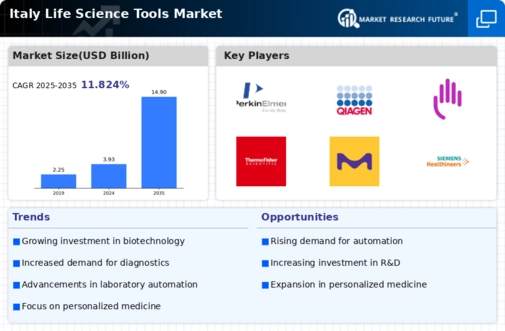Rising Investment in Biotechnology
The life science-tools market in Italy is experiencing a surge in investment, particularly in biotechnology. This sector has attracted substantial funding, with investments reaching approximately €1.5 billion in recent years. Such financial influx is likely to enhance research capabilities and foster innovation in the development of advanced tools and technologies. The Italian government, alongside private investors, is increasingly recognizing the potential of biotechnology to drive economic growth. This trend may lead to the establishment of new laboratories and research facilities, further stimulating the life science-tools market. As a result, the demand for sophisticated instruments and reagents is expected to rise, creating opportunities for manufacturers and suppliers within the industry.
Growing Demand for Diagnostic Tools
The life science-tools market is witnessing a notable increase in the demand for diagnostic tools in Italy. With a focus on early disease detection and personalized treatment, healthcare providers are increasingly adopting advanced diagnostic technologies. The market for diagnostic tools is projected to grow at a CAGR of 8% over the next five years, driven by the need for accurate and timely diagnostics. This growth is likely to be fueled by the rising prevalence of chronic diseases and the aging population. Consequently, manufacturers in the life science-tools market are expected to innovate and expand their product offerings to meet the evolving needs of healthcare professionals and patients alike.
Increased Focus on Sustainable Practices
Sustainability is becoming a key focus within the life science-tools market in Italy. Companies are increasingly adopting eco-friendly practices in the development and manufacturing of life science tools. This shift is driven by both regulatory pressures and consumer demand for sustainable products. The market is likely to see a rise in the availability of tools that minimize environmental impact, such as biodegradable materials and energy-efficient technologies. As sustainability becomes a priority, manufacturers may need to adapt their strategies to align with these trends, potentially leading to innovation and differentiation within the life science-tools market.
Expansion of Academic and Research Institutions
The expansion of academic and research institutions in Italy is significantly impacting the life science-tools market. Universities and research centers are increasingly collaborating with industry partners to advance scientific knowledge and develop cutting-edge tools. This trend is likely to enhance the demand for life science tools, as researchers require high-quality instruments and reagents for their studies. Furthermore, government initiatives aimed at promoting scientific research are expected to bolster funding for these institutions, thereby increasing their capacity to conduct innovative research. Consequently, the life science-tools market may experience growth driven by the heightened activity within academic and research sectors.
Regulatory Support for Research and Development
Regulatory frameworks in Italy are becoming increasingly supportive of research and development activities within the life science-tools market. The Italian Medicines Agency (AIFA) has implemented streamlined processes for the approval of new tools and technologies, which may facilitate faster market entry for innovative products. This regulatory environment encourages companies to invest in R&D, potentially leading to breakthroughs in various fields such as genomics and proteomics. As a result, the life science-tools market is likely to benefit from a more dynamic and competitive landscape, with an influx of novel products that cater to the diverse needs of researchers and clinicians.


















Leave a Comment